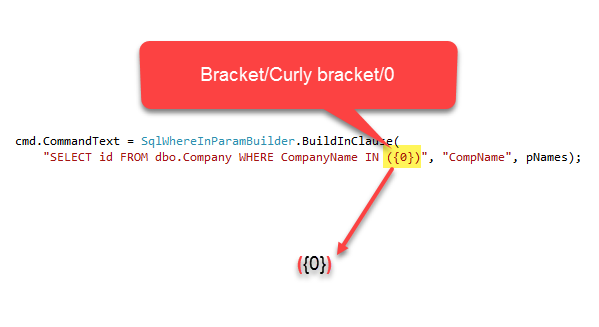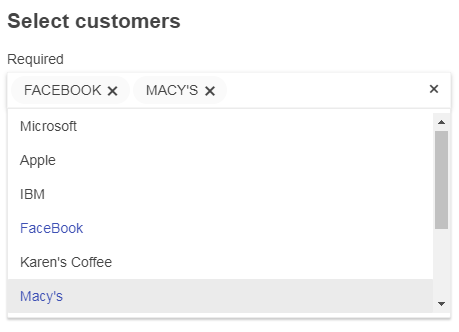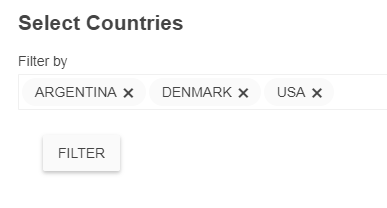SQL-Server dynamic C#: Dynamic WHERE IN conditions in C#for SQL Server
Introduction
This article provides methods for writing SQL WHERE IN conditions in C# dynamically for SQL-Server tables using SqlClient data provider. WHERE IN condition are used to assist for an alternative to using OR conditions in a SELECT and DELETE statement are most common. Common reasons in a .NET solution, one example would be to allow a user to filter on customers by multiple countries while another example may be to allow a user to remove multiple customers. Both methods may start with a multi-select list or multi-select checkbox control/input dependent on the project type e.g. ASP.NET, WPF or Windows Forms etc.
01/2022 code sample have been updated from .NET Framework 4.6 to .NET Core 5, C#9
The following screenshots are from web example pages using multi-select dropdown using jQuery.
IN vs OR
In short both return the same results yet when there are many conditions with OR syntax one must repeat the field name for each condition and also means when in a complex statement more to maintain.
SELECT id
FROM dbo.Company
WHERE CompanyName = 'FaceBook'
OR CompanyName = 'Macy''s';
While with IN the field name is used once, less to maintain.
SELECT id
FROM dbo.Company
WHERE CompanyName IN ( 'FaceBook', 'Macy''s' );
Code methods
To dynamically create a WHERE IN condition the type of parameter needs to be considered along with attention needs to be paid for apostrophes in string values. This means when creating parameters Command.Parameters.AddWithValue will not work properly as AddWithValue can take a numeric and convert to a string for instance. This means Command.Parameters.Add needs to be used and set SqlDbType property of a parameter to the proper type.
For this the following method GetDbType accepts a generic type and returns the proper SqlDbType.
using System;
using System.Collections.Generic;
using System.Data;
namespace SqlUtilityLibrary
{
public static class SqlTypeHelper
{
private static readonly Dictionary<Type, SqlDbType> TypeMap;
// Create and populate the dictionary in the static constructor
static SqlTypeHelper()
{
TypeMap = new Dictionary<Type, SqlDbType>
{
[typeof(string)] = SqlDbType.NVarChar,
[typeof(char[])] = SqlDbType.NVarChar,
[typeof(byte)] = SqlDbType.TinyInt,
[typeof(short)] = SqlDbType.SmallInt,
[typeof(int)] = SqlDbType.Int,
[typeof(long)] = SqlDbType.BigInt,
[typeof(byte[])] = SqlDbType.Image,
[typeof(bool)] = SqlDbType.Bit,
[typeof(DateTime)] = SqlDbType.DateTime2,
[typeof(DateTimeOffset)] = SqlDbType.DateTimeOffset,
[typeof(decimal)] = SqlDbType.Money,
[typeof(float)] = SqlDbType.Real,
[typeof(double)] = SqlDbType.Float,
[typeof(TimeSpan)] = SqlDbType.Time
};
/* not in above then added them */
}
/// <summary>
/// Get SqlDbType for givenType
/// </summary>
/// <param name="giveType"></param>
/// <returns><see cref="SqlDbType"/></returns>
public static SqlDbType GetDbType(Type giveType)
{
// Allow nullable types to be handled
giveType = Nullable.GetUnderlyingType(giveType) ?? giveType;
if (TypeMap.ContainsKey(giveType))
{
return TypeMap[giveType];
}
throw new ArgumentException($"{giveType.FullName} is not a supported .NET class");
}
}
}
GetDbType (above) is called by the following language extension method where T may be one of the types TypesMap Dictionary above.
public static void AddParamsToCommand<T>(this SqlCommand cmd, string pPrefix, IEnumerable<T> parameters)
{
var parameterValues = parameters.Select((paramText) => paramText.ToString()).ToArray();
var parameterNames = parameterValues.
Select((paramText, paramNumber) => $"@{pPrefix}{paramNumber}").ToArray();
for (int index = 0; index < parameterNames.Length; index++)
{
cmd.Parameters.Add(new SqlParameter()
{
ParameterName = parameterNames[index],
SqlDbType = SqlTypeHelper.GetDbType(typeof(T)),
Value = parameterValues[index]
});
}
}
The following takes a partial WHERE IN condition e.g. SELECT Id FROM Customers WHERE Country IN ({0}). {0} will be replaced with one parameter for each value passed in from the last parameter. pPrefix prefixes each parameter name e.g. if the prefix was country and there were three country names we end up with @country1, @country2, @country3.
public static string BuildInClause<T>(string partialClause, string pPrefix, IEnumerable<T> parameters)
{
string[] parameterNames = parameters.
Select((paramText, paramNumber) => $"@{pPrefix}{paramNumber}").ToArray();
var inClause = string.Join(",", parameterNames);
var whereInClause = string.Format(partialClause.Trim(), inClause);
return whereInClause;
}
Example
Using the following table
CREATE TABLE dbo.Company
(
id INT IDENTITY(1, 1)
NOT NULL ,
CompanyName NVARCHAR(MAX) NULL ,
CONSTRAINT PK_Company PRIMARY KEY CLUSTERED ( id ASC )
WITH ( PAD_INDEX = OFF, STATISTICS_NORECOMPUTE = OFF,
IGNORE_DUP_KEY = OFF, ALLOW_ROW_LOCKS = ON,
ALLOW_PAGE_LOCKS = ON ) ON [PRIMARY]
)
ON [PRIMARY] TEXTIMAGE_ON [PRIMARY];
Using a multi-select control with company names displayed and for each item in the control a primary key, pass in a list of keys or an array to the method to return records that have the keys passed in. To demonstrate this a unit test is perfect.
In the following test method primary keys are passed to a function. The variable expectedResults contain the company names expected to be returned for the keys. In a real application more than a list of strings would be returned but all we need to validate are names of companies since if these are correct the same will hold true of records or a list of a class.
[TestMethod]
public void IntWhereConditions()
{
// arrange
var expectedResults = new List<string>()
{
"Apple",
"FaceBook",
"Karen's Coffee"
};
// act
var results = GetByPrimaryKeys(new List<int>() { 2,4,5 });
// assert
Assert.IsTrue(expectedResults.SequenceEqual(results));
}
The following method takes each parameter, builds a parameter in cmd, the SqlCommand then sets values for each parameter.
public List<string> GetByPrimaryKeys(List<int> pIdentifiers)
{
mHasException = false;
var customerList = new List<string>();
using (var cn = new SqlConnection() { ConnectionString = ConnectionString })
{
using (var cmd = new SqlCommand() { Connection = cn})
{
// create one parameter for each key in pIdentifiers
cmd.CommandText = SqlWhereInParamBuilder.BuildInClause(
"SELECT CompanyName FROM dbo.Company WHERE id IN ({0})", "CompId", pIdentifiers);
// populate each parameter with values from pIdentifiers
cmd.AddParamsToCommand("CompId", pIdentifiers);
try
{
cn.Open();
var reader = cmd.ExecuteReader();
if (reader.HasRows)
{
while (reader.Read())
{
customerList.Add(reader.GetString(0));
}
}
}
catch (Exception ex)
{
mHasException = true;
mLastException = ex;
}
}
}
return customerList;
}
Since SqlWhereInParamBuilder.BuildInClause figured out parameter types no matter the type passed in you can pass in strings rather than a int as per the above example e.g.
public List<int> GetCustomersKeysBack(List<string> pNames)
{
mHasException = false;
var customerList = new List<int>();
using (var cn = new SqlConnection() { ConnectionString = ConnectionString })
{
using (var cmd = new SqlCommand() { Connection = cn })
{
// Create a parameter for each value in pNames
cmd.CommandText = SqlWhereInParamBuilder.BuildInClause(
"SELECT id FROM dbo.Company WHERE CompanyName IN ({0})", "CompName", pNames);
// populate parameters created in BuildInClause
cmd.AddParamsToCommand("CompName", pNames);
try
{
cn.Open();
// After running this test click on the test method calling
// this method and select "output" to view the SELECT statement.
Console.WriteLine(cmd.ActualCommandText());
var reader = cmd.ExecuteReader();
if (reader.HasRows)
{
while (reader.Read())
{
customerList.Add(reader.GetInt32(0));
}
}
}
catch (Exception ex)
{
mHasException = true;
mLastException = ex;
}
}
}
return customerList;
}
Dates can be done also yet they are more complex depending on if there is a time aspect of the date. Images and binary types also present issues too so these methods work best with strings and numeric types.
Usage
Include project SqlUtilityLibrary into your Visual Studio solution, add a reference to your project for SqlUtilityLibrary and write statements as per below.
Create the SELECT [field list]
Append WHERE IN ({0})
Note parenesis then curly brace followed by 0 then close curly brace then close parenesis.

How to use in your project
- Add the project from the code sample named SqlUtilityLibrary into your Visual Studio solution.
- Add a reference to the library in your project.
- Write SQL statements as per above.
Source code
Clone or fork the following GitHub repository.
Running code samples
- Open BaseSqlServerConnections class in BaseLibrary project and change DatabaseServer from KARENS-PC to your server name or .\SQLEXPRESS.
- Open script.sql located in WhereConditionsTest unit test project.
- Line 7 and line 8, check the path for FILENAME, ensure it points to your SQL-Server path, if different than alter the path.
- Run the script in Visual Studio or SSMS (SQL-Server Management Studio).
- In Visual Studio open Test Explorer.
- Build the solution.
- Run the test from Test Explorer or run each test one at a time.
Summary
In this article you have been presented with a library which allows the creation of dynamic WHERE IN conditions for your database solution. To better understand the mechanics implement the ActualCommandText language extension to view the final SQL statements as shown in the method GetCustomerKeysBack in TestBase class within the test project.

